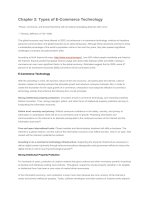Business analytics methods, models and decisions evans analytics2e ppt 10
Bạn đang xem bản rút gọn của tài liệu. Xem và tải ngay bản đầy đủ của tài liệu tại đây (6.28 MB, 69 trang )
Chapter 10
Introduction to Data Mining
Data Mining
Data mining is focused on better understanding of characteristics and patterns among
variables in large databases using a variety of statistical and analytical tools.
◦ It is used to identify relationships among variables in large data sets and understand hidden
patterns that they may contain.
◦ XLMiner software implement many basic data mining procedures in a spreadsheet
environment.
The Scope of Data Mining
Data Exploration and Reduction
identifying groups in which elements are in some way similar
Classification
analyzing data to predict how to classify a new data element
Association
analyzing databases to identify natural associations among variables and create rules for target marketing or
buying recommendations
Cause-and-effect Modeling
developing analytic models to describe relationships between metrics that drive business performance
Data Exploration in XLMiner
XLMiner ribbon
◦ XLMiner can sample from an Excel worksheet
Example 10.1: Using XLMiner to Sample from a
Worksheet
Click inside the database
XLMiner > Data Analysis > Sample >
Sample from Worksheet
Select variables and move to right
pane
Choose sampling options
Example 10.1 Continued
Results
Data Visualization
XLMiner has the capability to produce boxplots, parallel coordinate charts, scatterplot
matrix charts, and variable charts.
◦ These are found from the Explore button in the Data Analysis group.
Example 10.2: A Boxplot for Credit Risk Data
XLMiner >Data Analysis > Explore >
Chart Wizard > Boxplot
In the second dialog, choose Months
Employed as the variable to plot on
the vertical axis.
In the next dialog, choose Marital
Status as the variable to plot on the
horizontal axis.
Click Finish
Parallel Coordinates Chart
A parallel coordinates chart consists of a set of vertical axes, one for each variable
selected. For each observation, a line is drawn connecting the vertical axes. The point
at which the line crosses an axis represents the value for that variable.
A parallel coordinates chart creates a “multivariate profile,” and help an analyst to
explore the data and draw basic conclusions.
Example 10.3: A Parallel Coordinates Chart for Credit Risk Data
XLMiner > Data Analysis >
Explore > Chart Wizard >
Parallel Coordinates
In the second dialog, choose
Checking, Savings, Months
Employed, and Age as the
variables to include.
Yellow = low credit risk; blue = high
Scatterplot Matrix
A scatterplot matrix combines several scatter charts into one panel, allowing the user
to visualize pairwise relationships between variables.
Example 10.4: A Scatterplot Matrix for Credit Risk Data
XLMiner > Data Analysis >
Explore > Chart Wizard >
Scatterplot Matrix
In the next dialog, check the
boxes for Months Customer,
Months Employed, and Age and
click Finish.
Variable Plot
A variable plot plots a matrix of histograms for the variables selected.
Example 10.5: A Variable Plot of Credit Risk Data
XLMiner > Data Analysis >
Explore > Chart Wizard >
Variable Plot
In the next dialog, check the
boxes for the variables you
wish to include and click
Finish.
Dirty Data
Real data sets that have missing values or errors. Such data sets are called “dirty” and need to be “cleaned” prior to
analyzing them.
Approaches for handling missing data.
◦
◦
◦
Eliminate the records that contain missing data
Estimate reasonable values for missing observations, such as the mean or median value
Use a data mining procedure to deal with them. XLMiner has the capability to deal with missing data in the Transform menu in
the Data Analysis group.
Try to understand whether missing data are simply random events or if there is a logical reason. Eliminating sample
data indiscriminately could result in misleading information and conclusions about the data.
Cluster Analysis
Cluster analysis, also called data segmentation, is a collection of techniques that seek
to group or segment a collection of objects (observations or records) into subsets or
clusters, such that those within each cluster are more closely related to one another
than objects assigned to different clusters.
◦ The objects within clusters should exhibit a high amount of similarity, whereas those in different
clusters will be dissimilar.
Cluster Analysis Methods
In hierarchical clustering, the data are not partitioned into a particular cluster in a single step.
Instead, a series of partitions takes place, which may run from a single cluster containing all
objects to n clusters, each containing a single object.
◦
◦
Agglomerative clustering methods proceed by series of fusions of the n objects into groups.
Divisive clustering methods separate n objects successively into finer groupings.
Hierarchical clustering may be represented by a two-dimensional diagram known as a
dendrogram, which illustrates the fusions or divisions made at each successive stage of
analysis.
Agglomerative vs. Divisive Clustering
Distance Measures
Euclidean distance is the straight-line distance between two points
The Euclidean distance measure between two points (x1, x2, . . . , xn) and (y1, y2, . . .
, yn) is
Agglomerative Clustering Methods
Single linkage clustering (nearest-neighbor)
◦
The distance between groups is defined as the distance between the closest pair of objects, where only pairs
consisting of one object from each group are considered.
◦
At each stage, the closest 2 clusters are merged
Complete linkage clustering
◦
The distance between groups is the distance between the most distant pair of objects, one from each group
Average linkage clustering
◦
Uses the mean values for each variable to compute distance between clusters
Ward’s hierarchical clustering
Uses a sum of squares criterion
Example 10.6: Clustering Colleges and Universities Data
Cluster the institutions using the
five numeric columns in the data
set.
XLMiner > Data Analysis >
Cluster < Hierarchical Clustering
Example 10.6 Continued
Second dialog
Check the box Normalize input data to
ensure that the distance measure
accords equal weight to each variable
Example 10.6 Continued
Step 3
Select the number of clusters
Example 10.6 Continued
Results
Example 10.6 Continued
Dendogram
◦ A horizontal line
shows the cluster
partitions









